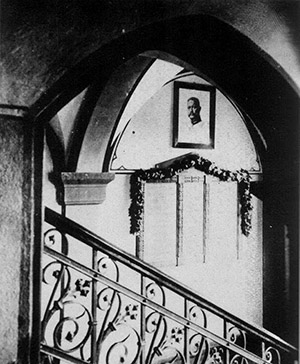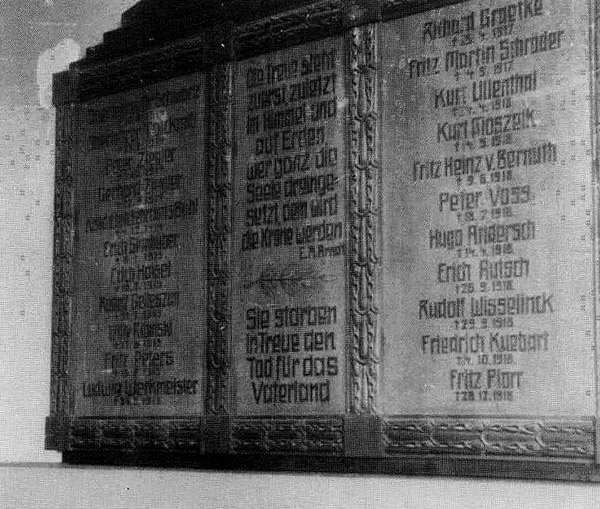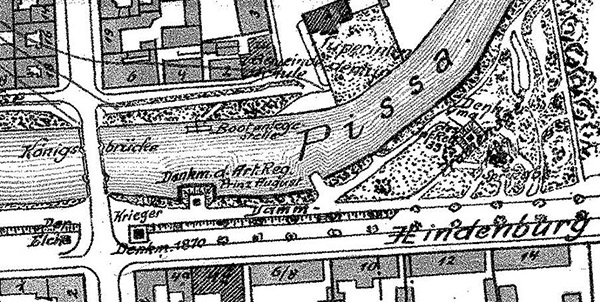Monuments of the First World War in Gumbinnen
Since Gumbinnen found itself in the thick of military action in 1914-1915, the city and its surroundings were “rich” in monuments and burial sites reminiscent of those sad events.
In this article we will look at the burials and monuments in the city of Gumbinnen (Gusev). A separate article will be devoted to the burials and monuments of the First World War in the Kreis (district) of Gumbinnen.
Burials
In total, two large burial sites were formed in Gumbinnen during the battles of
the First World War in East Prussia. Data on the number of fallen soldiers
buried in the city vary. Based on the lists of the German People's Association
for the Care of Graves (Volksbund Deutsche Kriegsgräberfürsorge) and data
provided by Max Dehnen (Der Kriegsgräber in Ostpreussen von 1914/15), the
approximate figures for those buried are as follows:
Russians – 194 people
Germans – 390 people
Austrians – 2 people
Romanians – 2 people.
The first burials were carried out in the Old City Cemetery (Altstädtischen Friedhof) on Meelbeсkstrasse (now Shkolnaya Street) - which was founded at the end of the 18th century. Territorially, the cemetery was divided into three main sections:
— Evangelical Lutheran community;
— Evangelical Reformist community;
— Norutschatschen rural community (now this territory is located within the city
limits of Gusev)
There were two more small areas:
- Jewish community;
- military burials.
The first to be buried in the Old Cemetery were infantryman Tillack from the 43rd Infantry Regiment (Musk. Tillack, Inf. R.43), who died in border clashes on August 10, 1914, and corporal Klinkusch from the 3rd Grenadier Regiment (Gefr. Klinkusch vom Gren. R.3), who died in the first major combat clash near Stallupönnen (now Nesterov) on August 17, 1914.
Subsequent military clashes brought new losses, and accordingly, new graves appeared in the cemetery.
After the Battle of Gumbinnen on August 20, 1914, 17 German soldiers were buried, and after the September clashes near the Romincka Forest, 4 German soldiers were buried.
Also after the September battles, the first Russian graves appeared – 15 people, most likely those who died in the battle for the station and Gumbinnen itself.
Around the same time, in the fall, a so-called “honorary section” (Ehrenteil auf dem Altstädtischen Friedhof) was created at the cemetery in order to somehow distinguish the military burials from the general mass.
The last soldier buried in the Old Cemetery during the period of military clashes was Lieutenant Arnicke from the reserve of the 5th Dragoon Regiment (Leutn. Arnicke Res.Drag. R.5.).
By the end of autumn 1914, the Old Cemetery could no longer accommodate all the dead. The city authorities allocated a new area for military burials at that time on the outskirts of the city, on Sodeikerstrasse (now Krasnoarmeyskaya and Molodyozhnaya streets). This burial site was named the Military Cemetery (Kriegerfriedhof) or Heroes' Cemetery (Heldenfriedhof). The first burials there appeared in late October - early November 1914. The first to be buried were a fusilier from the 33rd Fusilier Regiment Rohrmoser (Füs. Rohrmoser vom Füs. R.33) and a non-commissioned officer of the Landwehr Infantry Regiment No. 33 Schemionek (Uffz. Schemionek vom Landw. Inf. R.33). Then the grenadiers of the East Prussian regiments who died on November 9, 1914, in a clash near the Romincka Forest were buried.
There is no information about the time when the first Russian graves appeared at the Military Cemetery. It is known for certain that 142 Russian soldiers were buried with full military honors in February 1915.
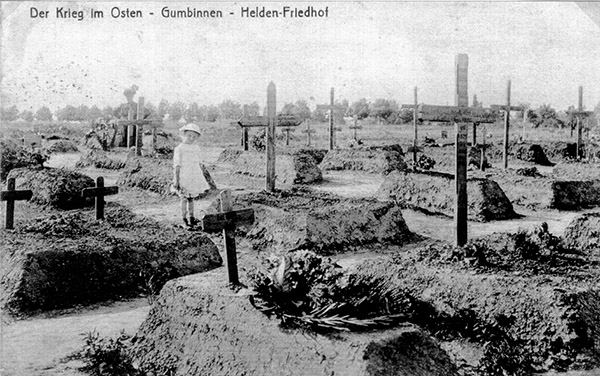
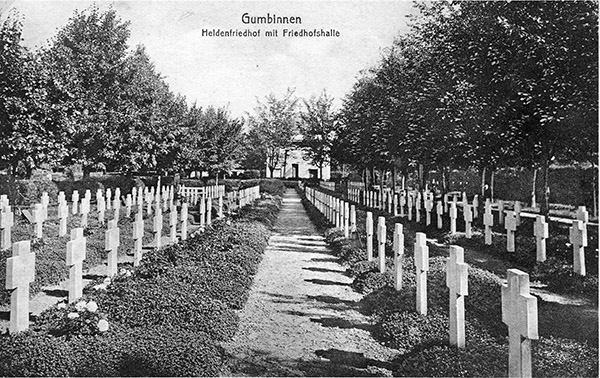
After the end of military operations in East Prussia, those who died in hospitals or in captivity continued to be buried in the cemeteries. After the war, civilians also found their final resting place at the Military Cemetery, and so the cemetery received a second name - the New Cemetery (Neuer Friedhof), but its part with military burials continued to be called the "Cemetery of Heroes". At the same time, a chapel was built at the entrance to the cemetery.
The total number of people buried in the Gumbinnen cemeteries is as follows:
Old City Cemetery – 17 Russian and 44 German soldiers and officers;
Heroes’ Cemetery – 177 Russian and 346 German dead, as well as 2 Romanian and 2
Austrian soldiers, apparently died in captivity.
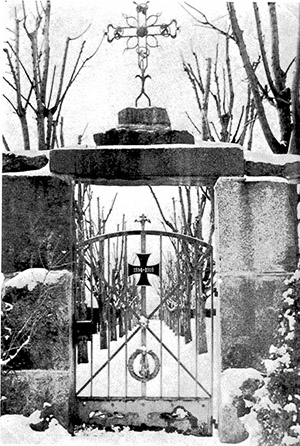
The German Volksbund for the Care of War Graves, founded in late 1919, maintained order in the cemeteries. The residents of Gumbinnen brought flowers and wreaths to the monuments and graves every year. Concrete crosses and tombstones were installed on the mass graves. At the entrance to the New Cemetery, next to the chapel, a monument was erected with the text:
Heldenfriedhof Gumbinnen
Hire
530 Krieger
Stars
in the Fatherland
(Gumbinnen Heroes' Cemetery.
530 warriors are buried here.
They died for their Fatherland").
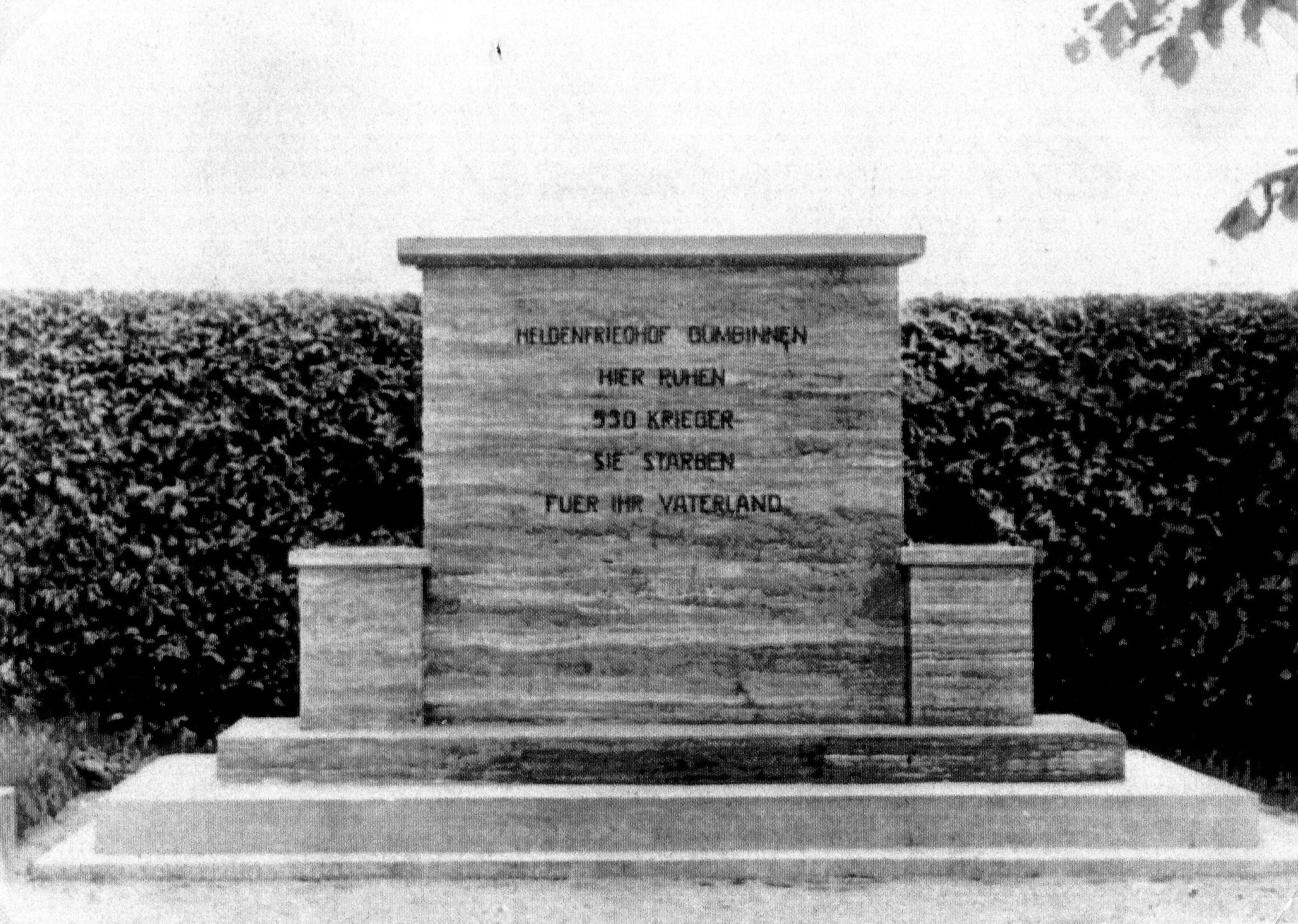
After the end of World War II, the fate of the burials was tragic. In the 1960s, the Old Cemetery was razed, and the territory was redeveloped into a park. And only in 2000, a stone with an Orthodox and Latin cross was installed at the supposed site of the military burial. In 2013, a cross was installed near the stone, and in 2014, the territory of the supposed burial site was completely landscaped, two crosses and an information plaque were installed.
The territory of the New Cemetery was largely built up with residential buildings and only the chapel, which was given to the city’s Catholic community, survived.
Another small burial site was in the garden near the garrison hospital (Grabanlage im Garten des Garnisonlazaretts), where 5 German soldiers from the Landwehr regiments were buried.
Monuments
As a garrison town, Gumbinnen had several regiments permanently assigned to it: fusilier, lancer and artillery. All of these regiments took part in the First World War. And subsequently, monuments were erected dedicated to the memory of fallen regimental comrades.
33rd Fusilier Regiment
The monument to the fallen comrades of the Fusilier Regiment (Fusilier Regiment
Graf Roon 33) in the First World War was erected on the promenade along the
Pissa River on 16 October 1921. The monument was a massive carved cube with a
cross on top.
The inscription on the monument read:
1914-1918
During the war,
the soldiers of the armed forces
were sent to the rank
of commander of the Confederate
Fusilier Regiment, Count Roon
(Ostpr.) Nr. 33.
(1914-1918
To the fallen comrades of the World War
in eternal memory
from former colleagues
East Prussian Fusilier Regiment Count Roon
No. 33").
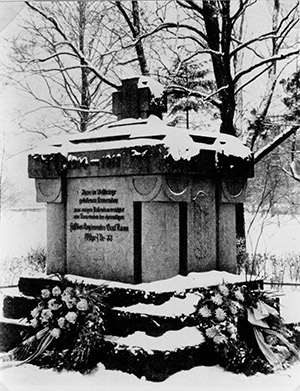
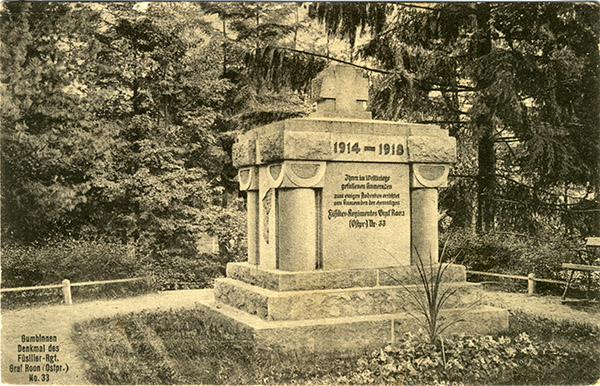
And on the reverse side there is a small clarification about the number of regimental comrades who died:
102 officers, 3152 under-officers
and soldiers
lie to their children in the
Fatherland
(102 officers, 3152 non-commissioned officers
and the privates gave their lives
for the Fatherland").
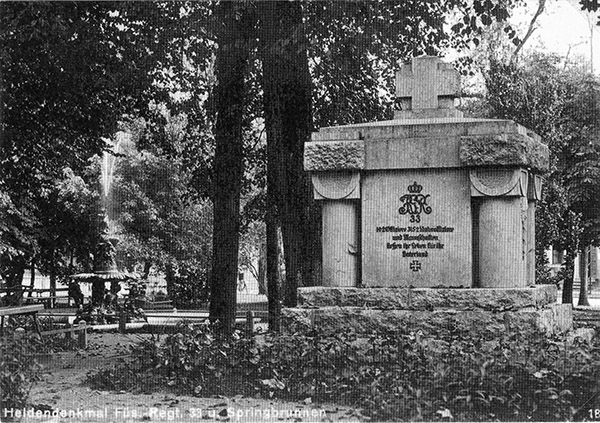
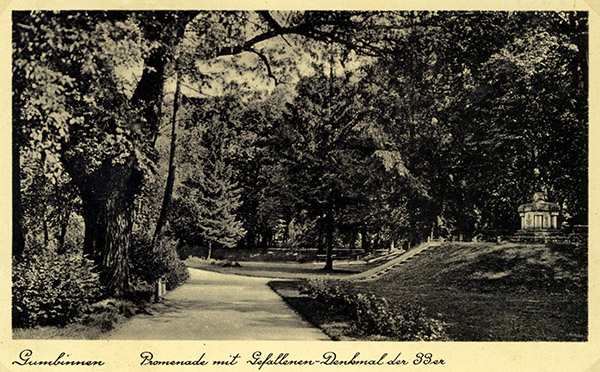
After the end of World War II, the monument was not preserved. Its base survived and for a long time the artificial hill on which the monument stood was clearly visible in the area.
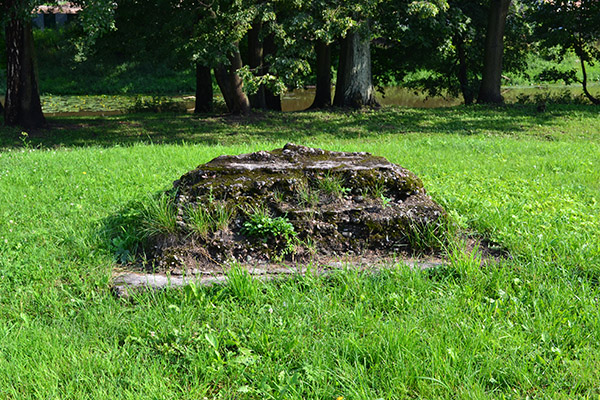
In 2014, a Russian monument dedicated to the First World War, “Bayonet Charge,” was erected on this site.
1st Field Artillery Regiment
A monument to the fallen regimental comrades of the Field Artillery Regiment
Prince August of Prussia No. 1 (Feldartillerie-Regiment Prinz August von
Preussen (1 Lithauisches)) in Gumbinnen on the Dammpromenade on the banks of the
Pissa.
It was interesting because the monument was crowned with a figure of a soaring Prussian eagle, which is more typical for monuments dedicated to the Franco-Prussian War.
The monument had an inscription:
The decrees
of the defeated
regiment commanders in the Weltkrieg
commanded the officers,
sub-officers and commanders
of the Field Artillery Regiment,
Prince Augustus of Preussen
(1st Lit. Nr. 1)
(In memory of the fallen
in the World War
to regimental comrades, officers,
non-commissioned officers and privates
field artillery
Prince August of Prussia Regiment
(1 Lithuanian No. 1)».
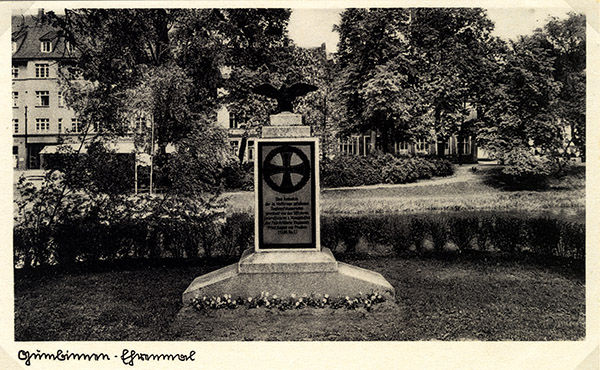
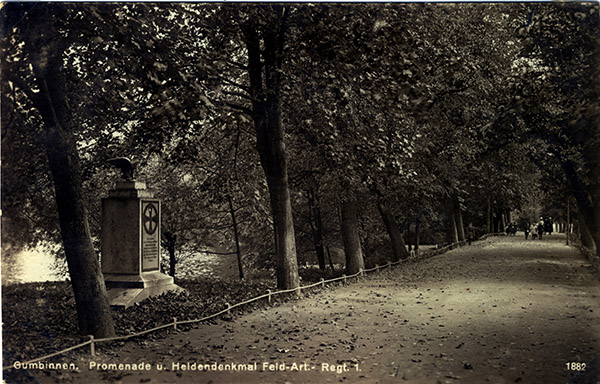
The monument was most likely erected in the early 1920s, as it was already marked on the 1924 map. It stood until the onset of Soviet times.
The post-war perpetuation of the heroes of the Great Patriotic War in street names also affected Gusev. The former Linden- (Hindenburg-) strasse was renamed Zoya Kosmodemyanskaya Street. And later they decided to erect a monument to her on this street. The location was not bad, opposite the "division headquarters", the former district administration (Kreishaus). And the base (slabs) from the German regimental monument became the pedestal of the monument to Z. Kosmodemyanskaya.
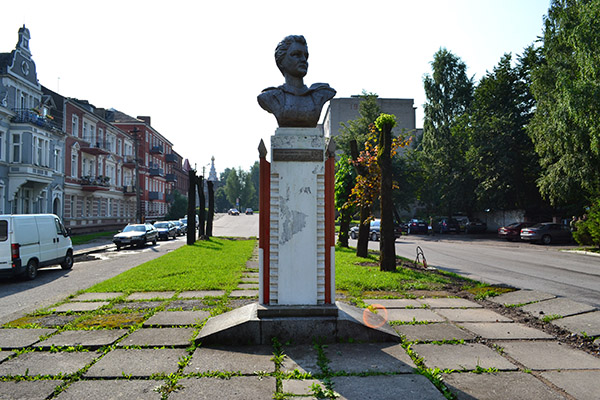
In 2013, during the reconstruction of the street and the monument, the foundation slabs were dismantled and the monument was moved. The place where the monument was originally located was landscaped and by now no traces remain.
But this regiment had another monument, erected in the 1930s near the new artillery barracks on the former Erich-Koch-Strasse (now Sovetskaya Street). It was a processed field stone with an image of an iron cross and the following inscription:
The fall
of the
field soldiers. Regts. Nr.1
Prince August
of Preussen
during the war
1914-1918
(In memory of the fallen
Field Artillery Regiment No. 1
named after Prince August of Prussia
1914-1918").

The monument has not survived to this day; now there are greenhouses in its place.
8th Uhlan Regiment
The regimental monument to the fallen of the 8th Uhlan Regiment (Ulanen Regiment
Graf Dohna 8) was located, like the previous ones, on the bank of the Pissa,
opposite the modern city House of Culture. It was a processed fieldstone with a
short inscription enclosed in a medallion:
The
fallen
chambers
are in a barracks
and
the evil
spirits are in danger
(To the fallen comrades
with gratitude and loyalty
former lancers of the Don regiment").

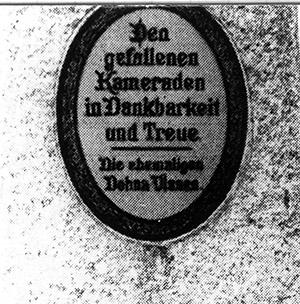
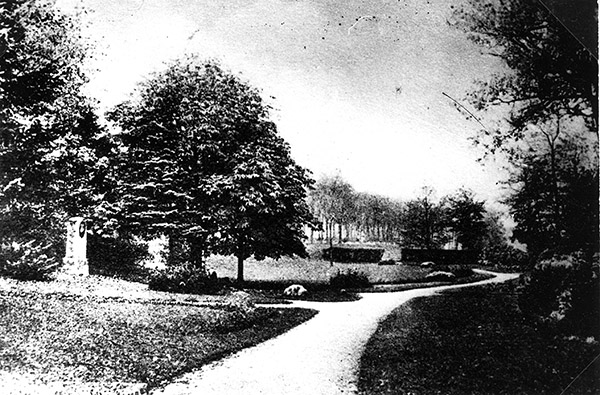
Like all the previous ones, this monument has not survived, and it is not even
possible to determine the place where it was erected.
There was also a monument to the members of the sports club who died during the
First World War. It was erected near the sports club where the football teams
"Prussia 07" and "Lithuania 09" trained. The monument listed the names of all
the deceased members of the club with the date of their death. The monument has
not survived to this day, and no traces remain in the place where it stood.

And another memorial sign, reminding of those who died in the First World War - a memorial plaque in the Friedrichschule boys' gymnasium (now the Gusev Agro-Industrial College). On the landing between the first and second floors on the main staircase hung a memorial plaque, which listed the teachers and students of the gymnasium who died in the war.
